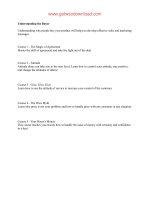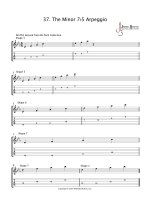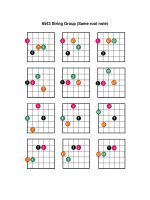PHP the ultimate tủ tài liệu bách khoa
Bạn đang xem bản rút gọn của tài liệu. Xem và tải ngay bản đầy đủ của tài liệu tại đây (2.22 MB, 182 trang )
PHP:TheUltimate
StepbyStepguideforbeginnerson
howtolearnPHPandMYSQL
programminginjust6hours
ByEmilyGoldstein
©Copyright2015byWECANTBEBEATLLC
TableofContents
INTRODUCTION
CHAPTER1:SETTINGUPYOURSERVER
0.1CreatingthepublicHTMLPages
0.2Creatingthedatabaseandit’stables
0.3Addinguserstothedatabase
0.4Userlog-in:Authentication
CHAPTER2:SETTINGUPTHEHOMEPAGEFORLOGGED-INUSERSAND
LOGGING-OUT
2.1TestingPageSecurity
2.2Addingdatatothelist-UserAccessOnly
CHAPTER3:DISPLAYINGDATAINTHEHOMEPAGE
3.1EditingData
3.2Deletingdata
3.3Displayingpublicdata
CHAPTER4:DYNAMICCONTENTANDTHEWEB
4.1HTTPandtheInternet
4.2PHPandMySQL’sPlaceinWebDevelopment
4.3TheComponentsofaPHPApplication
4.4IntegratingManySourcesofInformation
4.5RequestingDatafromaWebPage
CHAPTER5:EXPLORINGPHP
5.1PHPandHTMLText
5.2CodingBuildingBlocks
CHAPTER6:PHPDECISION-MAKING
6.1Expressions
6.2OperatorConcepts
6.3BreakingOut
6.4Looping
CHAPTER7:FUNCTIONS
7.1CallingFunctions
7.2DefiningFunctions
7.3Object-OrientedProgramming
CHAPTER8:ARRAYS
8.1ArrayFundamentals
CHAPTER9:WORKINGWITHMYSQL
9.1MySQLDatabase
9.2ManagingtheDatabase
9.3UsingphpMyAdmin
9.4DatabaseConcepts
9.5StructuredQueryLanguage
CHAPTER10:DATABASEBESTPRACTICES
10.1DatabaseDesign
10.2BackingUpandRestoringData
10.3AdvancedSQL
CHAPTER11:GETTINGPHPTOTALKTOMYSQL
11.1Theprocess
11.2QueryingtheDatabasewithPHPFunctions
CHAPTER12:WORKINGWITHFORMS
12.1BuildingaForm
12.2Templates
CHAPTER13:PRACTICALPHP
13.1StringFunctions
13.2Dateandtimefunctions
13.3FileManipulation
13.4CallingSystemCalls
CHAPTER14:XHTML
14.1WhyXHTML?
14.2XHTMLandXMLNamespaces
14.3XHTMLVersions
14.4CreatingXHTMLwithPHP
CHAPTER15:MODIFYINGMYSQLOBJECTSANDPHPDATA
15.1ChangingDatabaseObjectsfromPHP
15.2ManipulatingTableData
15.3ManipulatingTableData
INTRODUCTION
Areyouinspiredbytheideaofmakingyourownwebsite?Everthoughtabouthow
coolisittohaveawebsitethathasalog-in/log-outfunctionality?Needtofigure
outhowtoCreate,Read,UpdateorDelete(CRUD)recordsinadatabase?Have
youlosttrackofyourpastinstructionalexercises?Havingconsideredallthese
questions,I’mgoingtoshowyouhowtomakeawebsitewithoutanyoutsidehelp
whereyouwillknoweachandeverysubtleelementonhowthePHPwebsitecode
functions.Ifyouarenewtoback-endwebdevelopment,thisinstructionalbookis
foryou.
I’llclarifyeverythinginyourpointofinterestsothatyouwon’tneedtoresearch
somespecifictechniquesbeingusedinPHP.Tokeepthingsasstraightforwardas
possible,wewon’tbeusinganycomplexsystems.Additionally,Iwon’tbe
concentratingonthewebsitesdesignbecauseweareafterthefunctionalities.
However,it’sanythingbutdifficulttoexecutethedesign.Whatthisbookwillbe
doingisaneasyyetexhaustiveanalysisoftheentirePHPCodingprocess.
So,whatisPHP?Intheeventthatyouownasiteorneedasitedesigned,youmay
needtoknowtheresponsetothisquestion.Consider-in1999itwasassessed
thereweremorethan100,000sitesutilizingPHPtoupgradetheirownparticular
site.Today,therearemorethan1,000,000sitesutilizingPHP.
PHPisaprevalentandbroadlyutilizedprogrammingdialectutilizedforsite
improvement.PHPstandsforPHP:HypertextPreprocessor.
IntheearlyyearsoftheInternet,mostdestinationswerestaticcontentpages.As
theInternetadvanced,individualsneededsiteswithmoreintuitivefunctionality,
forexample,visitorbooksandcontactframes.PHPwastheidealinstrumentand
stillistoday.
PHPisanexceptionallystrongandexperiencedprogrammingdialect.Itwas
initiallyreleasedin1995andhasdevelopedtoturnintooneofthefavoreddialects
forsiteadvancement.Itrunsontheserversideandisexceptionallysecure.Now
thatit’soutintheopen,mostfacilitatingorganizationsgivePHPtheirfacilitating
bundles.
Intheeventthatyourequireaninteractivesite,withcomponentslikevisitor
booksandcontactshapes,youcanlearnPHPprogrammingyourself,purchasea
sitebundle,orcontractaProfessionalPHPProgrammer.Agreatnumberof
peopledon’thaveroom,scheduleorcapabilitytotakeinaprogrammingdialect
e.g.PHPandchoosetoacquiresitepacks.Onerecentmyrecentcustomers
acquiredado-it-withoutanyoneelse’shelpsitepackfromavastre-sell.These
packs,howeverofferfundamentalsitesthatcanworkforafewindividuals,have
littlefunctionalityandofferrestrictedhighlights.Inthewakeofbattlingwithit,
thiscustomeremployedmetodevelophissite.Afterfinishingit,henowhasasite
thatislovelyandhasincrediblefunctionalityandinteractiveelementsthathis
customersneed.Hissiteisalongwaypastwhatasitepackcouldhaveevergiven.
ThisisthedistinctionofPHP!
CHAPTER1:SETTINGUPYOURSERVER
Sincenowyouhaveeverythingsetandreadytogo,asthenutsandboltsof
programminggoes,weshouldbeginbymakingabasicshoutoutof“hiworld”in
theserver.
Tostartwith,gotothecatalogwhereyouintroducedyourXAMPP(Commonlyin
C:\xampp).Fromthatpoint,gotothehtdocsenvelope(Commonlyin
C:\xampp\htdocs)andmakeanorganizernamed“MyFirstWebsite”.
Fromthatpart,youhavenowmadeaLocalURLforyourwebsite.Thatenvelope
willbeutilizedtosupplyinallwebsiterecords(.html,.php,.css,.js,andsoforth.).
Openupyourcontentmanagerandnowwecanbegin!
Iutilizesuperbcontentasmywordprocessor.Ontheoffchancethatyou’re
utilizingNotepad++oranyotherprocessors,it’salright.It’snotsomuchofa
majorcomponentyetbecauseit’sonlyaninclinationonwhichoneyoumight
wanttoutilize.
WhatwewilldoisafundamentalHTMLpageandpresentation“hiworld”from
theserver,utilizinganessentialPHPlanguagestructure.Wewillthensortthe
accompanyinggrammar:
ABOVECODING:
<html>
<head>
<title>MyfirstPHPWebsite</title>
</head>
<body>
echo“
HelloWorld!
”;?>
</body>
</html>
Savethedocumenttothe“MyFirstWebSite”Folderandnameitas“index.php”.
(Indexasseenonthetopbarofthepicture)
Giventhatyouhavetherecord,weshouldnowopenyourXAMPPcontrolboard.
Intheeventthatitdoesn’tshowuponyourdesktop,itissituatedinyourXAMPP
envelopeasseenonthepicture:
Nowthatit’sthere,RunyourApacheandmySQLbytappingthe“Begin”catchon
theactivitiessegment.YououghttoseeanirregularPID(s)andthedefaultport
number.Apacheisthenameofourwebserverinwhichitwillhandleeveryone
ofthedocumentsandalsoserveasthecorrespondencetothewebprogramand
MySQLisourdatabasewhichwillstorethegreaterpartofourdata.
Openupyourwebprogramandinthelocationbar,clicklocalhost.Yououghtto
seethemenuofyourXAMPP.
Ontheoffchancethatit’sthefirsttimewhenyourunit,itwillaskwhatdialect
youwouldinclinetoward,justbasicallypickoneanditwillleadyoutothemenu.
Ontheoffchancethatyouwillseetheindexislocalhost/xampp,it’stheplacethe
defaultpagedrivesyouregardlessofthewhetheryouwriteinlocalhost.
OntheoffchancethatyouwillseethattheURLisMyFirstWebsite,itisgotten
fromthehtdocsorganizeranditnaturallyperusesdocumentsthatarenamed
“index”(Beitindex.html,index.aspx,andsoon),whichservesasthedefaultpage.
Nonetheless,writinglocalhost/MyfirstWebsite/index.phpisimportant.Youcan
alsomakeyourcustomnamefortheURLbyessentiallyrenamingtheorganizer
buthowaboutwesimplysticktoMyFirstWebsitefornow.
Note:Ifyoudon’thavearecordnamedlistandyouentertheURL,youwillgeta
slip404fornothavingthedocumentontheserver.Incaseyoudohavedistinctive
documentsthatarenotnamedindex<extention>,youneedtodeterminethe
particularrecordname.E.g:localhost/MyfirstWebsite/page.php.
0.1CreatingthepublicHTMLPages
Thenextstepisthatweshouldchangeourwebsiteandincludearegistrationpage
whereourclientscanenrollandalsoaLog-inpageimmediatelyaftergetting
enlisted.Weshouldalsoadjustourlandingpagewiththeaccompanyingcode:
CODEABOVE:
<html>
<head>
<title>MyfirstPHPWebsite</title>
</head>
<body>
echo“
HelloWorld!
”;?>
<ahref=”login.php”>Clickheretologin
<ahref=”register.php”>Clickheretoregister
</body>
</html>
Itshouldbeobviousbynowthatwehavejustincluded2connectionswhichare
fortheLoginandregister.Weshouldmaketheregistrationpagefirst.Asyoucan
see,it’sonlyanessentialstructurewheretheclientcanincludehis/her
accreditations.Fortheloginpage,insertthiscode:
Insight:Justduplicatethesamecodetomakethingseasierandfaster.
login.php
CODEABOVE:
<html>
<head>
<title>MyfirstPHPWebsite</title>
</head>
<body>
LoginPage
<ahref=”index.php”>Clickheretogoback
<formaction=”checklogin.php”method=”POST”>
EnterUsername:<inputtype=”text”name=”username”required=”required”/>
Enterpassword:
<inputtype=”submit”value=”Login”/>
</form>
</body>
</html>
Fundamentally,it’sstillthesamecodeasfromtheregister.phpbutthe
adjustments/progressionsmadeweretheonesunderlined.
Tryrunninglocalhost/MyFirstWebsiteagainandyourpagesoughttoappearlike
this:
index.php
login.php
register.php
0.2Creatingthedatabaseandit’stables
Nowthathaveourmostimportantpageforallpeopleingeneral,howaboutwe
continuetothedatabase?
Tostartwith,selectlocalhost/phpmyadmin.Thiswillleadyoutothe
phpmyadminlandingpage:
Localhost/phpmyadmin
Fromthatpoint,gototheDatabasestabsituatedontopthenfromthecontentbox
inthecenter,selectfirst_dbthentaponmake.SimplyleavetheCollationas
shownbelow:
Youhavenoweffectivelymadeyourfirstdatabase.
Fromthatpoint,howaboutwemakeatableinwhichwecanenrollourclientsand
showcasedata?Tostartwith,clickonfirst_dbsituatedontheleftsideandmakea
tablenamedclientswith3segmentsthentaponGo.
Forthetable’sstructure,choosetohavetheaccompanyingfieldsthentapon
recovery:
Group:ColumnName-Type-Length-NullProperty-OtherProperties
Id-INT-N/A-NotNull-AutoIncrement
Username-varchar-50-Notnull
Secretkey-varchar-50-Notnull
Leaveeverythingasdefaultifitisnotdetermined.
Note:Youhavetosrolltotherightofthatpagefortheauto_increment.Isimply
alteredthephototofittheA_Ifield
Next,makeanothertablenamedrundownwith7sectionsandforthetable’s
structure:
id-INT-N/A-NotNull-AutoIncrement
pointsofinterest-content-Notnull
date_posted-varchar-30-Notnull
time_posted-Time-Notnull
date_edited-varchar-30-Notnull
time_edited-Time-Notnull
open-varchar-5-Notnull
0.3Addinguserstothedatabase
Sincewehaveourtables,weshouldproceedtothefunpart,gettingyour
enlistmentpageusable.Fromyourregistration.php,includethehtmlcodesaddonbelow:
register.php
Here’stheamplificationtothecode:
<html>
<head>
<title>MyfirstPHPWebsite</title>
</head>
<body>
RegistrationPage
<ahref=”index.php”>Clickheretogoback
<formaction=”checklogin.php”method=”POST”>
EnterUsername:<inputtype=”text”name=”username”required=”required”/>
Enterpassword:
<inputtype=”submit”value=”Register”/>
</form>
</body>
</html>
$_SERVER[“REQUEST_METHOD”]==“POST”-checksifthestructurehas
gottenaPOSTmethodwhenthesubmitbuttonhasbeenclicked.ThePOST
methodismadeinhtmlfromthemethod=”POST.
$_POST[‘’]-getsthenameoriginatingfromaPOSTmethod.Thisactionbasically
getstheinfowithregardstothenamefromthestructure.Foroursituationit’s
usernameandpassword.
mysql_real_escape_string()-exemplifiestheinformationintoastringtokeep
inputsfromSQLInjections.Thisguaranteesthatyourstringsdon’tescapefrom
extracharacters.
Afterthat,gotoyourregister.phpandattempttoinputanydatathenclickon
“Register”.FormysituationIputintheusernamextianandpasswordas123456.
Itoughttoshowtheinputsbelow.Here’smyspecimen:
Throughthispartyououghttohaveseenonthemostproficientmethodtoget
infothroughthestructureandhowtoaddittothedatabase.Onyourregister.php,
includethesupplementarycode:
Herearetheclarificationstothecode:
<html>
<head>
<title>MyfirstPHPWebsite</title>
</head>
<body>
RegistrationPage
<ahref=”index.php”>Clickheretogoback
<formaction=”checklogin.php”method=”POST”>
EnterUsername:<inputtype=”text”name=”username”required=”required”/>
Enterpassword:
<inputtype=”submit”value=”Register”/>
</form>
</body>
</html>
alert(“Usernamehasbeentaken!”);</script>’;//Promptstheuser
Print‘<script>window.location.assign(“register.php”);</script>’;//redirectsto
register.php
}
}
if($bool)
{
mysql_query(“INSERTINTOusers(username,password)VALUES(‘$username’,
‘password’)”);//insertsvalueintotableusers
Print‘<script>alert(“SuccessfullyRegistered!”);</script>’;//Promptstheuser
Print‘<script>window.location.assign(“register.php”);</script>’;//redirectsto
register.php
}
}
?>
mysql_connect(“Servername”,”ServerUsername”,”ServerPassword”)-The
sentencestructureusedtojoinwithourXAMPPserver.localhostor127.0.0.1is
thenameoftheserver.Thedefaultusernameisrootandnosecretwordfor
default.
mysql_select_db(“databasename”)-Selectsthedatabasetobeutilized.
thenagaindie(‘Message’)-Displaysthelapsemessageiftheconditionwasn’tmet.
mysql_query(‘sqlquestion’)-doestheSQLinquiries.
mysql_fetch_array(‘query’)-bringsallquestionsinthetabletoshoworcontrol
data.Itisputinaasacirclesothatitwouldquestionallcolumns.Observethat,
just1lineisquestionedpercirclethatisthereasonawhilecircleisvital.
$row[‘rowname’]-theestimationofthesectioninthepresentinquiry.Itis
representedasanexhibit.Foroursituation$rowisthenameofthevariablefor
ourcolumnontheupanddown.
Attempttheinputsthatyouhavemadebeforeandseewhathappens.Itoughtto
showthatyouhaveeffectivelyregistered.Attemptgoingtophpmyadminandsee
yourclientstable:
Congrats!Nowyouknowhowtoincludedataintothedatabasewithdata
validations.
0.4Userlog-in:Authentication
Subsequently,fortheloginpage,weshouldmakeanotherdocumentcalled
checklogin.php.Thereasonisbacktrackingtoourlogin.php,ourstructurehasan
activitycalled“checklogin.php”,especially
register.phpbecausetheback-endisdoneonthesamedocumenttoo.
Howaboutwenowcodethechecklogin.phpwiththeaccompanyinglanguage:
checklogin.php
session_start();
$username=mysql_real_escape_string($_POST[‘username’]);
$password=mysql_real_escape_string($_POST[‘password’]);
$bool=true;
mysql_connect(“localhost”,“root”,“”)ordie(mysql_error());//Connecttoserver
mysql_select_db(“first_db”)ordie(“Cannotconnecttodatabase”);//Connectto
database
$query=mysql_query(“Select*fromusersWHEREusername=’$username’”);//
Querytheuserstable
$exists=mysql_num_rows($query);//Checksifusernameexists
$table_users=“”:
$table_password=“”;
if($exists>0)//IFtherearenoreturningrowsornoexistingusername
{
while($row=mysql_fetch_assoc($query))//displayallrowsfromquery
{
$table_users=$row[‘username’];//thefirstusernamerowispassedonto
$table_users,andsoonuntilthequeryisfinished
$table_password=$row[‘password’];//thefirstpasswordrowispassedonto
$table_password,andsoonuntilthequeryisfinished
}
if(($username==$table_users)&&($password==$table_password))//checks
ifthereareanymatchingfields
{
if($password==$table_password)
{
$_SESSION[‘user’]=$username;//settheusernameinasession.Thisservesasa
globalvariable
header(“location:home.php”);//redirectstheusertotheauthenticatedhome
page
}
}
else
{
Print‘<script>alert(“IncorrectPassword!”);</script>’;//Promptstheuser
Print‘<script>window.location.assign(“login.php”);</script>’;//redirectsto
login.php
}
}
else
{
Print‘<script>alert(“Incorrectusername!”);</script>’;//Promptstheuser
Print‘<script>window.location.assign(“login.php”);</script>’;//redirectsto
login.php
}
?>
session_start()-Startsthesession.Thisisnormallydoneonestablishedpages.
Thereasonwhyweusedthisisbecauseitisneededforthe$_SESSION[‘’].
mysql_num_rows()-Thisyieldsawholenumber.Thisnumberseveryoneofthe
columnsdependingontheinquiry.
$_SESSION[‘name’]-Servesasthesessionnameforthewholesession.Thisis
moreorlesslikeopenvariablesinitemarrangedprogramming.Wewillbe
utilizingthisforrecognizingwhethertheclientisvalidatedornot.
Thenattempttotestyourdatawithawrongusernameandpassword.Itoughtto
givebackthepreferredprompt.Aftertesting,tryinputtingtherightvalues.It
oughttoleadyoutohome.php.
Note:home.phpdoesnotexistyetsoitwillcreateanerror404.
CHAPTER2:SETTINGUPTHEHOME
PAGEFORLOGGED-INUSERSAND
LOGGING-OUT
Nowthatwereconfirmed,letnowmakeourlandingpage(home.php)withthe
accompanyingsyntax:
home.php
CODEABOVE:
<html>
<head>
<title>MyfirstPHPWebsite</title>
</head>
session_start();//startsthesession
if($_SESSION[‘user’]){//checksiftheuserisloggedin
}
else{
header(“location:index.php”);//redirectsifuserisnotloggedin
}
$user=$_SESSION[‘user’];//assignsuservalue
?>
<body>
HomePage
<hello>!
<!—Display’susername—>
<ahref=”logout.php”>Clickheretogologout</a>
<formaction=”add.php”method=”POST”>
Addmoretolist:<inputtype=”text”name=”details”/>
Publicpost?<inputtype=”checkbox”name=”public[]”value=”yes”/>
<inputtype=”submit”value=”Addtolist”/>
</form>
Id Details Edit Delete
</body></html>
Here’stheexplanationtothecode:
session_start()-Basicallystartsthesession.Requiredfor$_SESSION[‘’].
header()-redirectstheuser.
Tryrefreshingyourbrowseranditshouldlooklikethis:
Nowthatwehaveourhomepage,let’strycreatingourlogout.phpandtestifthe
user’ssessionisoff.Whatwewillensureisthatiftheuserislogged-out,theuser
shouldn’taccesshome.php.Sohere’sthesimplesyntaxtologout.php:
logout.php









